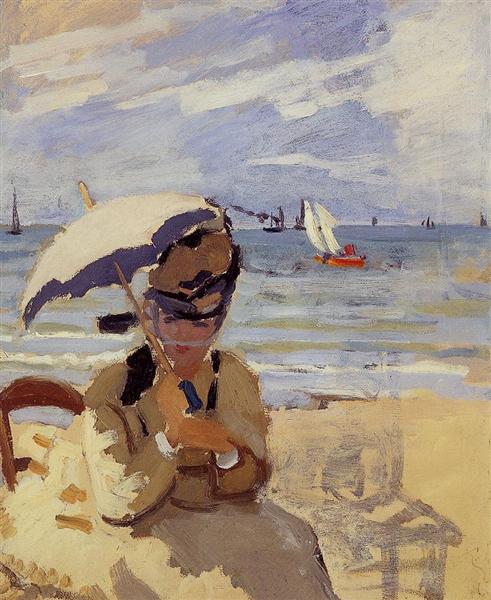Description
The work "Camille sitting on the beach of Truville" (1871) by Claude Monet stands as an intimate and revealing testimony of the painter's life and artistic perception, as well as his relationship with his wife, Camille Doncieux. In this painting, Monet captures a fleeting moment on the Norman coast, offering a view that transcends the merely visual to introduce the viewer into a rich and moving sensory experience.
In the center of the composition, Camille sits dignity in the sand, a portrait that distils both calm and emotional closeness. His figure, dressed in a clear attire that gently contrasts with the most vibrant background, becomes the core of visual narration. Monet's impressionist style is manifested through the loose and fluid brushstroke that characterizes the work, capturing light and movement with a spontaneity that seems to emulate the same sway of the waves that break on the shore. The choice of representation of Camille is not only an act of love, but also a symbol of everyday life and the enjoyment of the present moment, something that is essential in the impressionist approach.
The color palette is one of the most outstanding characteristics of this painting. Monet uses tones that cover a luminous spectrum, from the clear and soft beiges and blue to the nuances of green in the background, suggesting a fresh and live atmosphere. These colors, treated with a technique that allows the viewer's eyes to interact with the pictorial surface, create a sensation of immediacy and connection with the environment, where light plays a fundamental role in the revelation of shape and space. The energetic brushstroke and the careful disposition of the tones seem to look at the horizon, inviting the viewer to contemplate the vast sky and the sea, which are often interspersed in Monet's work.
While Camille is the central character, the environment also has its voice. Trouville Beach, a popular holiday destination at the time of Monet, is presented not only as an aesthetic scenario, but as a symbol of emerging modernity and the pleasure of life in the outdoors. The image evokes a coincidence that appears as intentional, presenting a rest scene and enjoyment in a context of social and artistic transformation. Monet, with his often carefree approach, invites reflection on intimacy and connection with nature, characteristic of his work, which he would resonate over time in the development of modern art.
"Camille sitting on the beach of Truville" is inscribed in a series of works where Monet portrays his wife at various times, reflecting not only his love for her, but also her devotion to the capture of the life that surrounds them. The works of this period are emblematic of the impressionist approach, where the focus on the light, color and capture of the moment are fundamental principles. This painting also provides a personal context to understand the relationship that Monet had with Camille, who was not only his wife, but also his muse in the exploration of light and its effects on the human landscape.
When contemplating this work, we are reminded that impressionism is not simply a technique or a style, but a way of seeing and feeling the world. Monet, in his poetic vision and loaded with emotion, manages to capture a pause in time, a moment of reflection and beauty that continues to resonate with the contemporary spectators, connecting us all with the essence of the ephemeral and the eternal.
KUADROS ©, a famous paint on your wall.
Hand-made oil painting reproductions, with the quality of professional artists and the distinctive seal of KUADROS ©.
Reproduction service paintings With a guarantee of satisfaction. If you are not completely satisfied with the replica of your painting, we refund your money 100%.

